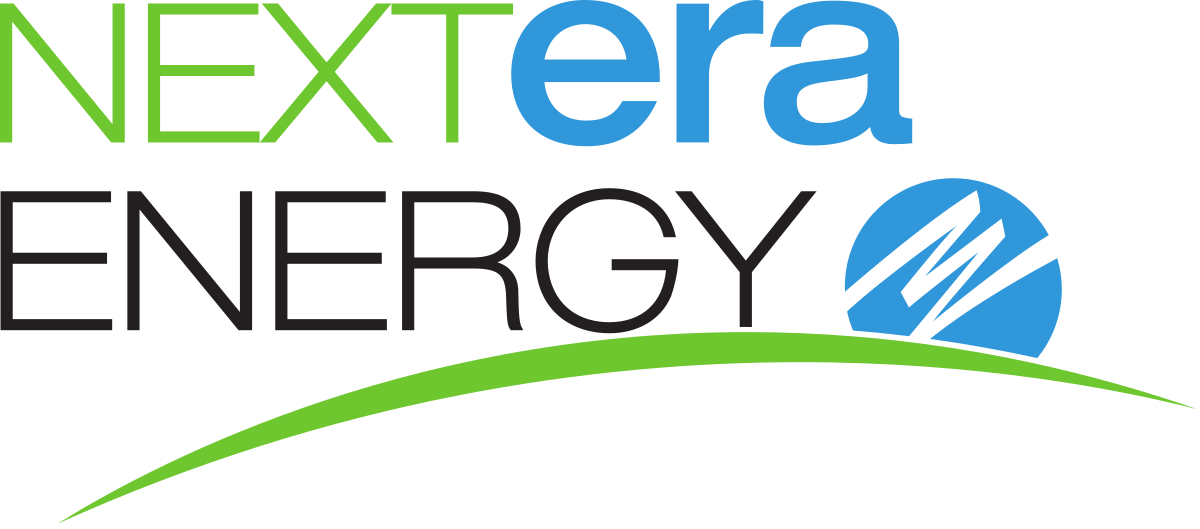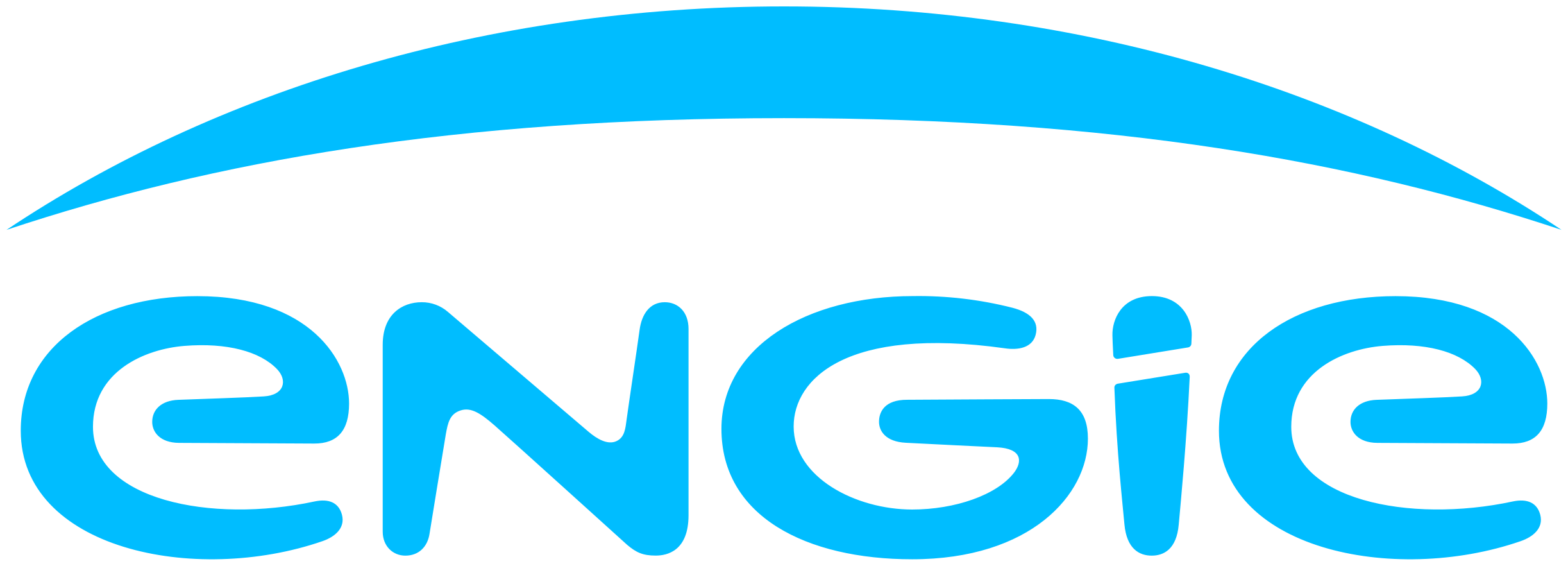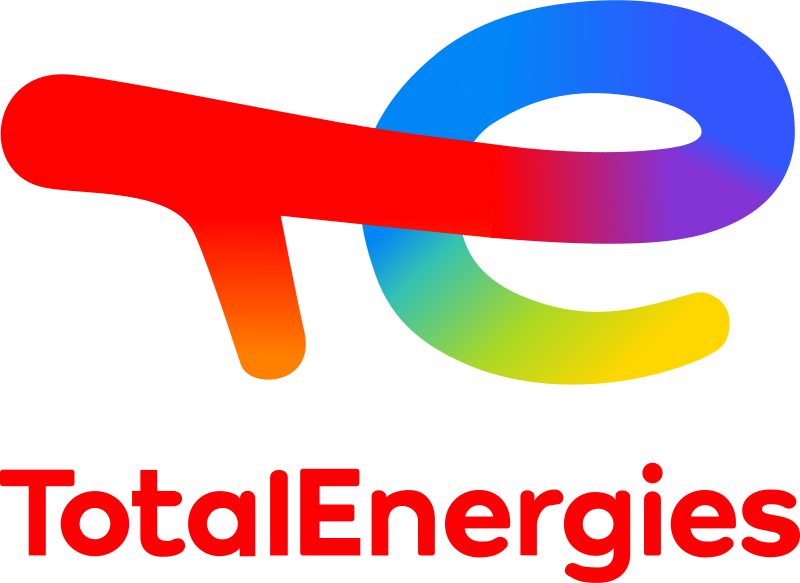Global Solar Power Market: By Component, By Technology, By System Type, By End User, By Region & Segmental Insights Trends and Forecast, 2024 – 2034
- Industry: Energy & Power
- Report ID: TNR-110-1128
- Number of Pages: 420
- Table/Charts : Yes
- June, 2024
- Base Year : 2024
- No. of Companies : 10+
- No. of Countries : 29
- Views : 10056
- Covid Impact Covered: Yes
- War Impact Covered: Yes
- Formats : PDF, Excel, PPT
Solar power refers to the conversion of sunlight into electricity through the use of solar panels or photovoltaic cells. This renewable energy source harnesses the abundant energy emitted by the sun and converts it into usable electricity, offering a sustainable alternative to conventional fossil fuels. Solar power systems typically consist of solar panels composed of numerous solar cells made from semiconductor materials, such as silicon, which generate direct current (DC) electricity when exposed to sunlight. Inverters then convert this DC electricity into alternating current (AC) electricity, which is compatible with the electrical grid or can be used directly by electrical devices. Solar power is a clean and renewable energy solution with minimal environmental impact, contributing to reduced greenhouse gas emissions and mitigating the effects of climate change. Its versatility and scalability make it suitable for a wide range of applications, from residential rooftops to large-scale solar farms, driving the transition towards a more sustainable energy future.
One of the primary demand drivers for solar power is the increasing global focus on sustainability and environmental responsibility. As concerns about climate change escalate, governments, businesses, and individuals are seeking cleaner, renewable energy sources to reduce carbon emissions and mitigate environmental impact. Solar power, being abundant, accessible, and emission-free, aligns perfectly with these objectives. Government policies, such as renewable energy targets, feed-in tariffs, and tax incentives, further incentivize the adoption of solar energy. Additionally, advancements in solar technology, such as improved efficiency and decreased costs, make solar power increasingly attractive from an economic standpoint. The growing demand for energy independence and resilience also plays a significant role, particularly in regions susceptible to energy shortages or geopolitical instability. Furthermore, consumer awareness and preferences for environmentally friendly products and services drive demand for solar power solutions in both residential and commercial sectors, fostering a robust and expanding market for solar energy worldwide. In terms of revenue, the global solar power market was worth US$ 256.2 Bn in 2023, anticipated to witness CAGR of 6.2% during 2024 – 2034.

Global Solar Power Market Dynamics
Climate Change Mitigation: Increasing concerns over climate change drive the adoption of solar power as a clean, renewable energy source, aiding in the reduction of greenhouse gas emissions. Technological advancements and economies of scale have led to significant reductions in the cost of solar photovoltaic (PV) systems, making solar energy more competitive with conventional sources. Integrating solar power with other renewable energy sources, such as wind or hydropower, in hybrid energy systems can optimize resource utilization and enhance energy reliability.

Government Incentives: Subsidies, tax credits, feed-in tariffs, and renewable energy mandates incentivize investment in solar power infrastructure, stimulating market growth. Solar power enhances energy security by diversifying energy sources, reducing dependence on imported fossil fuels, and mitigating the risks associated with volatile fuel prices.
Intermittency and Variability: Solar power generation is subject to intermittency and variability due to weather conditions, requiring backup power or energy storage solutions to ensure grid stability. Integrating large-scale solar power into existing electricity grids poses technical challenges related to grid stability, voltage fluctuations, and intermittency management. While solar PV costs have decreased, the initial capital investment for solar power infrastructure remains relatively high, limiting adoption in some regions or markets.
Emerging Markets: Rapid urbanization, population growth, and increasing energy demand in emerging markets present significant opportunities for solar power deployment, particularly in regions with abundant sunlight. Advancements in energy storage technologies, such as batteries and pumped hydro storage, offer opportunities to address solar power intermittency and enhance grid reliability. Innovative financing models, such as solar leasing, power purchase agreements (PPAs), and green bonds, expand access to solar energy by reducing upfront costs and financial barriers.
 Solar Photovoltaic (PV) segment Has Garnered Major Market Share in the Global Solar Power Market During the Forecast Period (2024 – 2034).
Solar Photovoltaic (PV) segment Has Garnered Major Market Share in the Global Solar Power Market During the Forecast Period (2024 – 2034).
Solar photovoltaic (PV) technology has emerged as a cornerstone of the global shift towards renewable energy, driven by a myriad of demand drivers. One crucial factor is the increasing emphasis on energy security and independence, as solar PV systems enable decentralized electricity generation, reducing reliance on centralized power sources vulnerable to disruptions. Additionally, the pressing need to mitigate climate change and reduce carbon emissions propels the adoption of solar PV, offering a clean and sustainable alternative to fossil fuels. Economic incentives, such as declining solar panel costs and favorable government policies like feed-in tariffs and tax credits, further accelerate the uptake of solar PV systems. Technological advancements, including improvements in efficiency and energy storage solutions, enhance the attractiveness and reliability of solar PV installations. Moreover, the growing awareness of environmental sustainability among consumers and businesses drives demand for solar PV as a responsible energy choice. These demand drivers collectively propel the widespread deployment of solar PV, reshaping the global energy landscape towards a cleaner and more sustainable future.

By End User Utility Segment had the Highest Share in the Global Solar Power Market in 2023.
The integration of solar power into utility grids is propelled by several key demand drivers, particularly in the Asia-Pacific region. One significant factor is the increasing pressure to reduce carbon emissions and combat climate change. Utilities are under growing scrutiny to transition towards cleaner energy sources, and solar power presents a viable solution to meet renewable energy targets. Additionally, the declining costs of solar technology make it economically advantageous for utilities to invest in solar power generation. Moreover, the decentralization of energy production is reshaping the utility landscape, with solar power enabling distributed generation and empowering consumers to become prosumers. Policy support and incentives from governments further incentivize utilities to embrace solar energy, fostering a conducive regulatory environment. Furthermore, the resilience and reliability offered by solar power, particularly in remote or disaster-prone areas, drive utility investments in solar infrastructure. Altogether, these demand drivers underscore the pivotal role of solar power in shaping the future of utility grids in the Asia-Pacific region and beyond.
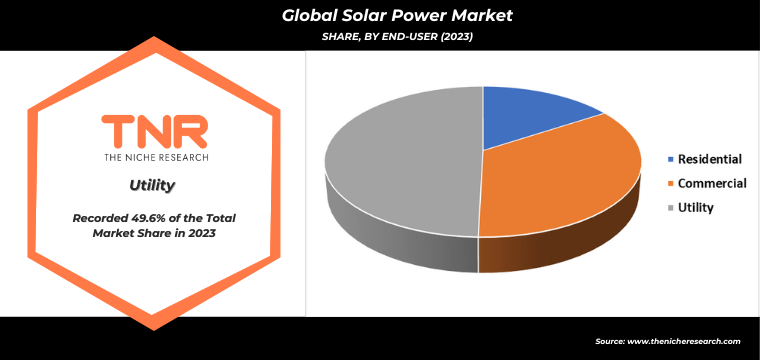
By Region, Asia Pacific Dominated the Global Solar Power Market in 2023.
The Asia-Pacific region stands at the forefront of the global solar power revolution, fueled by a multitude of demand drivers. One significant factor is the region’s rapidly growing population, accompanied by escalating energy demands. Governments across Asia-Pacific are increasingly investing in renewable energy to mitigate environmental concerns and reduce reliance on fossil fuels. Additionally, advancements in solar technology, coupled with decreasing costs, are making solar power increasingly attractive and accessible to both residential and commercial consumers. The region’s vulnerability to the impacts of climate change, such as extreme weather events and rising sea levels, further underscores the urgency of transitioning to cleaner energy sources. Moreover, initiatives aimed at achieving energy security and independence are driving widespread adoption of solar power solutions. As a result, the Asia-Pacific region is poised to lead the global shift towards a sustainable energy future powered by solar.

Competitive Landscape: Global Solar Power Market:
- Array Technologies Inc.
- Canadian Solar Inc.
- Enphase Energy Inc.
- First Solar Inc.
- JBM Group
- JinkoSolar Holding Co. Ltd.
- Maxeon Solar Technologies Ltd
- Origin Energy Limited
- SolarEdge Technologies Inc.
- Sunnova Energy International Inc.
- SunPower Corp
- Sunrun Inc.
- Other Market Participants
Global Solar Power Market Scope
| Report Specifications | Details |
| Market Revenue in 2023 | US$ 256.2 Bn |
| Market Size Forecast by 2034 | US$ 496.5 Bn |
| Growth Rate (CAGR) | 6.2% |
| Historic Data | 2016 – 2022 |
| Base Year for Estimation | 2023 |
| Forecast Period | 2024 – 2034 |
| Report Inclusions | Market Size & Estimates, Market Dynamics, Competitive Scenario, Trends, Growth Factors, Market Determinants, Key Investment Segmentation, Product/Service/Solutions Benchmarking |
| Segments Covered | By Component, By Technology, By System Type, By End User, By Region |
| Regions Covered | North America, Europe, Asia Pacific, Middle East & Africa, Latin America |
| Countries Covered | U.S., Canada, Mexico, Rest of North America, France, The UK, Spain, Germany, Italy, Nordic Countries (Denmark, Finland, Iceland, Sweden, Norway), Benelux Union (Belgium, The Netherlands, Luxembourg), Rest of Europe, China, Japan, India, New Zealand, Australia, South Korea, Southeast Asia (Indonesia, Thailand, Malaysia, Singapore, Rest of Southeast Asia), Rest of Asia Pacific, Saudi Arabia, UAE, Egypt, Kuwait, South Africa, Rest of Middle East & Africa, Brazil, Argentina, Rest of Latin America |
| Key Players | Array Technologies Inc., Canadian Solar Inc., Enphase Energy Inc., First Solar Inc., JBM Group, JinkoSolar Holding Co. Ltd., Maxeon Solar Technologies Ltd, Origin Energy Limited, SolarEdge Technologies Inc., Sunnova Energy International Inc., SunPower Corp, Sunrun Inc. |
| Customization Scope | Customization allows for the inclusion/modification of content pertaining to geographical regions, countries, and specific market segments. |
| Pricing & Procurement Options | Explore purchase options tailored to your specific research requirements |
| Contact Details | Consult With Our Expert
Japan (Toll-Free): +81 663-386-8111 South Korea (Toll-Free): +82-808- 703-126 Saudi Arabia (Toll-Free): +966 800-850-1643 United Kingdom: +44 753-710-5080 United States: +1 302-232-5106 E-mail: askanexpert@thenicheresearch.com
|
Global Solar Power Market
By Component
- Panels
- Inverters
- Racking and Mounting Components
- Solar Battery Storage Units
- Others
By Technology
- Solar Photovoltaic
- Concentrated Solar Power
By System Type
- Grid-tied Solar System
- Off-Grid Solar System
- Hybrid Solar System
By End User
- Residential
- Commercial
- Utility
By Region
- North America (U.S., Canada, Mexico, Rest of North America)
- Europe (France, The UK, Spain, Germany, Italy, Nordic Countries (Denmark, Finland, Iceland, Sweden, Norway), Benelux Union (Belgium, The Netherlands, Luxembourg), Rest of Europe)
- Asia Pacific (China, Japan, India, New Zealand, Australia, South Korea, Southeast Asia (Indonesia, Thailand, Malaysia, Singapore, Rest of Southeast Asia), Rest of Asia Pacific)
- Middle East & Africa (Saudi Arabia, UAE, Egypt, Kuwait, South Africa, Rest of Middle East & Africa)
- Latin America (Brazil, Argentina, Rest of Latin America)
Report Layout:
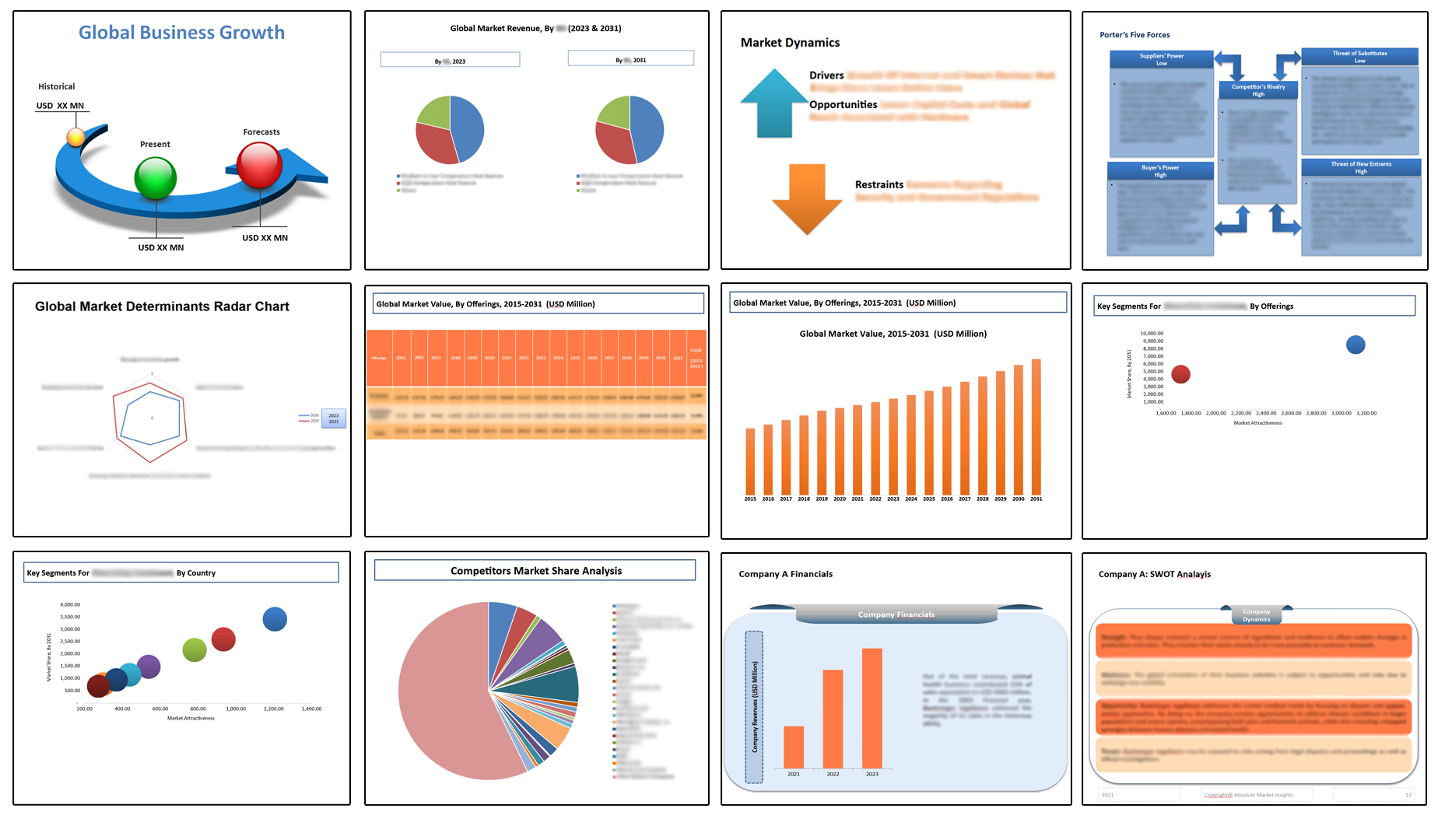
Table of Contents
Note: This ToC is tentative and can be changed according to the research study conducted during the course of report completion.
**Exclusive for Multi-User and Enterprise User.
Global Solar Power Market
By Component
- Panels
- Inverters
- Racking and Mounting Components
- Solar Battery Storage Units
- Others
By Technology
- Solar Photovoltaic
- Concentrated Solar Power
By System Type
- Grid-tied Solar System
- Off-Grid Solar System
- Hybrid Solar System
By End User
- Residential
- Commercial
- Utility
By Region
- North America (U.S., Canada, Mexico, Rest of North America)
- Europe (France, The UK, Spain, Germany, Italy, Nordic Countries (Denmark, Finland, Iceland, Sweden, Norway), Benelux Union (Belgium, The Netherlands, Luxembourg), Rest of Europe)
- Asia Pacific (China, Japan, India, New Zealand, Australia, South Korea, Southeast Asia (Indonesia, Thailand, Malaysia, Singapore, Rest of Southeast Asia), Rest of Asia Pacific)
- Middle East & Africa (Saudi Arabia, UAE, Egypt, Kuwait, South Africa, Rest of Middle East & Africa)
- Latin America (Brazil, Argentina, Rest of Latin America)
The Niche Research approach encompasses both primary and secondary research methods to provide comprehensive insights. While primary research is the cornerstone of our studies, we also incorporate secondary research sources such as company annual reports, premium industry databases, press releases, industry journals, and white papers.
Within our primary research, we actively engage with various industry stakeholders, conducting paid interviews and surveys. Our meticulous analysis extends to every market participant in major countries, allowing us to thoroughly examine their portfolios, calculate market shares, and segment revenues.
Our data collection primarily focuses on individual countries within our research scope, enabling us to estimate regional market sizes. Typically, we employ a bottom-up approach, meticulously tracking trends in different countries. We analyze growth drivers, constraints, technological innovations, and opportunities for each country, ultimately arriving at regional figures.Our process begins by examining the growth prospects of each country. Building upon these insights, we project growth and trends for the entire region. Finally, we utilize our proprietary model to refine estimations and forecasts.
Our data validation standards are integral to ensuring the reliability and accuracy of our research findings. Here’s a breakdown of our data validation processes and the stakeholders we engage with during our primary research:
- Supply Side Analysis: We initiate a supply side analysis by directly contacting market participants, through telephonic interviews and questionnaires containing both open-ended and close-ended questions. We gather information on their portfolios, segment revenues, developments, and growth strategies.
- Demand Side Analysis: To gain insights into adoption trends and consumer preferences, we reach out to target customers and users (non-vendors). This information forms a vital part of the qualitative analysis section of our reports, covering market dynamics, adoption trends, consumer behavior, spending patterns, and other related aspects.
- Consultant Insights: We tap into the expertise of our partner consultants from around the world to obtain their unique viewpoints and perspectives. Their insights contribute to a well-rounded understanding of the markets under investigation.
- In-House Validation: To ensure data accuracy and reliability, we conduct cross-validation of data points and information through our in-house team of consultants and utilize advanced data modeling tools for thorough verification.
The forecasts we provide are based on a comprehensive assessment of various factors, including:
- Market Trends and Past Performance (Last Five Years): We accurately analyze market trends and performance data from preceding five years to identify historical patterns and understand the market’s evolution.
- Historical Performance and Growth of Market Participants: We assess the historical performance and growth trajectories of key market participants. This analysis provides insights into the competitive landscape and individual company strategies.
- Market Determinants Impact Analysis (Next Eight Years): We conduct a rigorous analysis of the factors that are projected to influence the market over the next eight years. This includes assessing both internal and external determinants that can shape market dynamics.
- Drivers and Challenges for the Forecast Period:Identify the factors expected to drive market growth during the forecast period, as well as the challenges that the industry may face. This analysis aids in deriving an accurate growth rate projection.
- New Acquisitions, Collaborations, or Partnerships: We keep a close watch on any new acquisitions, collaborations, or partnerships within the industry. These developments can have a significant impact on market dynamics and competitiveness.
- Macro and Micro Factors Analysis:A thorough examination of both macro-level factors (e.g., economic trends, regulatory changes) and micro-level factors (e.g., technological advancements, consumer preferences) that may influence the market during the forecast period.
- End-User Sentiment Analysis: To understand the market from the end-user perspective, we conduct sentiment analysis. This involves assessing the sentiment, preferences, and feedback of the end-users, which can provide valuable insights into market trends.
- Perspective of Primary Participants: Insights gathered directly from primary research participants play a crucial role in shaping our forecasts. Their perspectives and experiences provide valuable qualitative data.
- Year-on-Year Growth Trend: We utilize a year-on-year growth trend based on historical market growth and expected future trends. This helps in formulating our growth projections, aligning them with the market’s historical performance.
Research process adopted by TNR involves multiple stages, including data collection, validation, quality checks, and presentation. It’s crucial that the data and information we provide add value to your existing market understanding and expertise. We have also established partnerships with business consulting, research, and survey organizations across regions and globally to collaborate on regional analysis and data validation, ensuring the highest level of accuracy and reliability in our reports.


